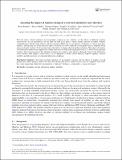Assessing the impact of typeface design in a text-rich automotive user interface
Author(s)
Reimer, Bryan; Dobres, Jonathan; Matteson, Steve; Gould, David; Chahine, Nadine; Levantovsky, Vladimir; Mehler, Bruce L.; Coughlin, Joseph F; ... Show more Show less
DownloadReimer-2014-Assessing the impact.pdf (413.8Kb)
PUBLISHER_CC
Publisher with Creative Commons License
Creative Commons Attribution
Terms of use
Metadata
Show full item recordAbstract
Text-rich driver–vehicle interfaces are increasingly common in new vehicles, yet the effects of different typeface characteristics on task performance in this brief off-road based glance context remains sparsely examined. Subjects completed menu selection tasks while in a driving simulator. Menu text was set either in a ‘humanist’ or ‘square grotesque’ typeface. Among men, use of the humanist typeface resulted in a 10.6% reduction in total glance time as compared to the square grotesque typeface. Total response time and number of glances showed similar reductions. The impact of typeface was either more modest or not apparent for women. Error rates for both males and females were 3.1% lower for the humanist typeface. This research suggests that optimised typefaces may mitigate some interface demands. Future work will need to assess whether other typeface characteristics can be optimised to further reduce demand, improve legibility, increase usability and help meet new governmental distraction guidelines.
Date issued
2014-07Department
Massachusetts Institute of Technology. Center for Transportation & Logistics; AgeLab (Massachusetts Institute of Technology)Journal
Ergonomics
Publisher
Taylor & Francis
Citation
Reimer, Bryan, Bruce Mehler, Jonathan Dobres, Joseph F. Coughlin, Steve Matteson, David Gould, Nadine Chahine, and Vladimir Levantovsky. “Assessing the Impact of Typeface Design in a Text-Rich Automotive User Interface.” Ergonomics 57, no. 11 (July 30, 2014): 1643–1658.
Version: Final published version
ISSN
0014-0139
1366-5847